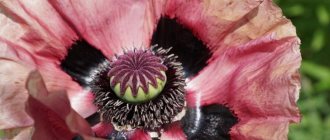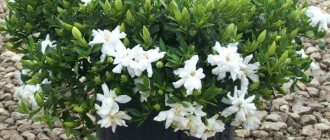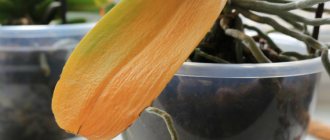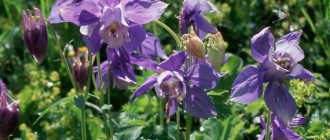If you choose the right place and time, follow simple nuances, you can easily root various flowers with 100% results. Light, temperature, humidity, substrate and rooting agent are responsible for the success of cuttings. In this article I tell you how to properly cut cuttings, help them grow new roots and take root well.
Balsam
Our grandmothers’ favorite plant always pleases with an abundance of bright flowers from white to red. Any sprig of balsam without flowers can be easily placed in water with an activated carbon tablet and after 5 days the first roots will appear.
Please note that the water must be settled and without chlorine. Next, the plant will take root well in the pot if you add loose, humus soil with potassium fertilizers.
Tradescantia
This cute climbing plant is very useful - it purifies the air in the house. Its striped shoots can reach several meters in length if left unpruned. The flowers are small and inconspicuous, mostly white, although there are species with lilac flowers.
Tradescantia propagates by rooting any piece of stem in water or soil. If rooting occurs in the ground, then frequent watering is necessary.
Types of cuttings
Cuttings are different. Which option to choose depends on the type of plant.
Green cuttings
In most cases, lignified cuttings are used for propagation, but some plants prefer to propagate by young green shoots.
Suitable for: barberry, weigela, hydrangea, derain, viburnum, bladderwort, lilac, chaenomeles, mock orange.
How to root. Actively growing young side shoots are cut with a sharp knife into segments with 2–3 internodes. The lower cut should be oblique at a distance of 0.5 - 1 cm from the bud. The upper cut is straight. It is even safer not to cut the cuttings, but to tear them off with the “heel” - the part of the stem from which they come. The lower leaves are torn off.
Then the cuttings are treated with a root formation stimulator - Kornevin or Heterauxin (1): either the lower part of the shoot is powdered with powder, or the drug is diluted in water and the cuttings are placed there for 6 hours. Then they are planted in a garden or pot to a depth of 2 cm. 3–5 cm of coarse sand must be poured on top of the ground: it protects the cuttings from rotting.
Stem cuttings
This option is suitable for herbaceous perennials - they use segments of shoots for propagation. They are cut until mid-summer.
Suitable for: aquilegia, astilbe, cornflower, helenium, delphinium, sedum, paniculata phlox.
Photo: shutterstock.com
How to root. The stems are cut into pieces with two internodes. They are dusted with any root formation stimulant and planted in the ground - preferably in a greenhouse. Such cuttings will take root quickly - if, for example, you plant phlox paniculata cuttings at the end of June, then in August you will get young plants with roots - they can already be transplanted into the flower garden.
Semi-lignified cuttings
These are shoots that have begun to cover the lower part with bark, but the upper part is still green.
Suitable for: hydrangeas, rhododendrons.
How to root. At the end of June, the tops of the semi-lignified shoots of the current year are cut off and cut into cuttings with two internodes. The lower leaves are torn off. Longitudinal cuts 1–2 cm long are made on the bark. The cuttings are dusted with a root formation stimulator and planted in pots in a mixture of peat and sand in equal quantities. After 2 - 3 months, roots will form, and the young plants can be transplanted into open ground.
Cyperus
The lush bush of this flower looks like a mini palm tree and is therefore very popular among gardeners. Cyperus cuttings can be cut and rooted in the spring. The exception is one species - Cyperus papyrus, which is propagated by seeds.
Before planting in the ground, you should keep the cut shoots in water with an activated carbon tablet. Cyperus is very fond of mineral fertilizing, so fertilizers should be added to the ground immediately after rooting.
Growing bamboo from cuttings
Bamboo is grown for its decorative appearance and thick leaves that look like a curtain. Bamboo grows quickly and is easily propagated by cuttings (the second method, dividing the roots, is used much less frequently).
Women's jeans: before you buy them, you need to pay attention to one detail
"Dad is offended." Agata Muceniece about her relationship with Priluchny after the divorce
Rare shot: Viktoria Isakova showed her grown-up daughter from Yuri Moroz (new photo)
Begonia
There are many varieties and types of begonia. At home, the most common types of begonias are leafy and bushy. For example, Bauer's leaf begonia reproduces well by rooting individual striped leaves in water or in the soil. And coral begonia takes root well both with shoots (twigs) and individual leaves placed in water.
It should be borne in mind that begonia roots do not appear immediately, but only after a couple of weeks. All this time you need to monitor the purity of the water or soil moisture.
Peperomia
Pleasant green bushes with heart-shaped or simply round leaves. Depending on the variety, peperomia can be either a mini plant or reach a height of 60 cm.
There is a rule: if the leaves of a plant are dark, then it needs shade and moderate watering, and if they are light, then it loves sunny windowsills and moist soil. Peperomia can be easily propagated by small branches that take root well in water.
Dracaena
All indoor types of dracaena look like miniature palm trees. This plant is easy to grow with minimal care. Since as the dracaena grows, it ages, its trunk becomes lignified and fewer shoots appear, it needs to be rejuvenated from time to time. This is done by rooting shoots cut from the top of the flower.
The cut crown is allowed to air dry for several hours and placed in a container with water. For better rooting, add a few drops of growth stimulator. You can also add half a tablet of activated carbon.
General conditions and criteria for plant propagation by stem cuttings
Propagating indoor plants by seeds is not a very effective method. Therefore, in most cases propagation by cuttings, or grafting, is used. Cuttings using stem cuttings is considered one of the methods for cutting indoor plants. Why is seed propagation considered ineffective? The processes of plant growth and development themselves are very complex in nature, since everything will depend on the methods of cultivation, the correct cultivation, as well as the strength of the plant itself.
Echeveria
Or echeveria, a succulent popular among gardeners. Small rosettes of echeveria look nice on the windowsill and take up little space. The maximum height of the plant is 35 cm. The colors of the leaves vary: from green to pink or silver. The flower prefers a mixture of humus with fine sand or pebbles. It is unpretentious in care and needs infrequent watering.
When cutting, cut off the lower large leaf, dry it in air for 3 - 4 hours, and then place it in slightly moist soil. The pot must be covered with a transparent plastic bag until the leaf takes root.
Lily propagation
The most common and easiest way to propagate lilies is by dividing nests of bulbs. It is based on the fact that the bulb forms several new buds at once, giving rise to daughter bulbs. They are separated and transplanted to another place. As they grow, the separated bulbs form an independent root system.
Division
Trim the lily stems very close to the soil surface. Then dig up the bulbs. To avoid damaging them, it is better to do this with a garden fork. Then clean the bulbs from the soil, remove all scales with spots and traces of rot. Trim the roots, leaving 10-15 cm. Disassemble large nests into bulbs. If they do not separate on their own, do so with a knife. Treat clean bulbs with roots for 20-30 minutes. in a weak solution of potassium permanganate or the drug "Maxim".
Landing
It is better to plant the prepared bulbs immediately, but if you need to wait, do not allow the roots to dry out. To do this, put the bulbs in boxes and sprinkle them with wet peat.
Plant the bulb to a depth three times its diameter. After planting, water the soil. We recommend reading the article about cardiocrinum.
Coleus
Bright coleus bushes with velvety dark red leaves are loved in many homes. The plant blooms with small pinkish or lilac flowers, which are almost invisible against the background of luxurious patterned leaves. Coleus loves peaty light soil and organic fertilizers. Once a year, it is customary to trim an overgrown bush and the cut branches can be rooted in water.
Epipremnum
A beautiful liana from the tropics has won the heart of more than one gardener. Epipremnum with variegated leaves should be grown in full sun, while varieties with green foliage prefer shade. For a beautiful appearance, the vine must be pruned annually to form a supported bush.
Trimmed shoots and leaves can be rooted in moist soil or in a container with clean water. The best time for shoots to grow roots is in spring or summer.
General rules for cuttings
Each type of cutting has its own characteristics, but there are also general rules that must also be taken into account.
Cut in the morning or in cloudy weather. At this time, the cuttings have more juice - these take root better.
Cover with bottle. Regardless of where the cuttings are planted - in pots or directly in the garden - they need to have a mini-greenhouse. The easiest way is to cover them with a plastic 5-liter bottle without a bottom or put them in a large jar with a lid (2). Such a shelter will help maintain high air humidity around the cuttings.
In a few weeks, young shoots will appear from the buds. At the end of summer, they begin to gradually open the bottle slightly so that the seedlings get used to the fresh air, and then the shelter is removed completely.
Spray. Covering with a bottle alone is not enough, because it is very hot in summer. The cuttings should be regularly sprayed with warm water. Ideally - daily. You can do it once a week (many people come to their dacha for the weekend), but in this case the soil around the cuttings should be constantly moist. So water them properly.
Protect from the sun. During rooting, cuttings should be in partial shade.
Insulate in winter. Rooted cuttings are left to overwinter where they were planted. And to prevent them from freezing, at the end of October - beginning of November, the soil around them is covered with a thick layer of fallen leaves or covered with several layers of non-woven fabric.
In the spring or autumn of next year, young plants are transplanted to a permanent place.
Pelargonium
Fragrant geranium is present in our homes in different forms: from dwarf zonal bushes to majestic and lush plants up to 1 m tall. Variegated geranium amazes with the beauty and shape of its leaves. But all types of pelargonium have one thing in common - they are easy to propagate by cuttings.
It is best to cut shoots when the plant is in a dormant period and is not blooming. Geraniums are usually pruned in autumn or spring. These branches are used for rooting in water or soil.
Caring for cuttings for better rooting
For the first week after cuttings, I do not open the greenhouses; they should be kept warm and in the light, under lamps. In the future I act according to the condition of the plant.
I monitor the humidity
— If it is clear that the soil is still quite moist and the cuttings are not getting wet from excessive condensation, then I do not open the greenhouse.
— If too much condensation forms, I ventilate the greenhouse little by little, and untie the bag, but do not remove it. If necessary, I lightly moisten the soil.
Photo: Successful rooting of Calibrachoa cuttings with Radigrin Yellow











